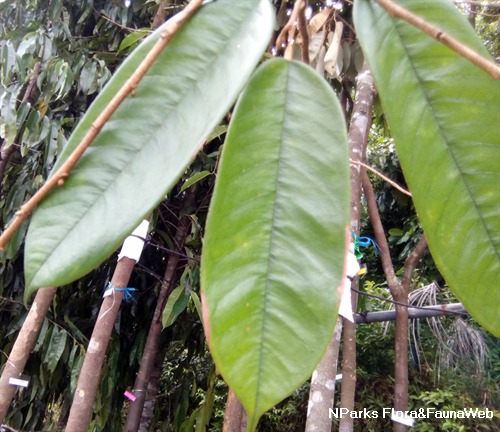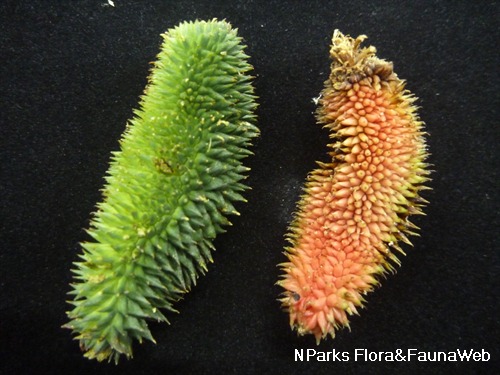
Back
Durio griffithii (Mast.) Bakh.
| Family Name: | Malvaceae |
| Common Name: | Griffith's Durian, Squirrel's Durian, Durian Burong, Durian Tupai |
Name
Classifications and Characteristics
| Plant Division | Angiosperms (Flowering Seed Plants) (Dicotyledon) |
|---|---|
| Plant Growth Form | Tree (Medium (16m-30m)) |
| Lifespan (in Singapore) | Perennial |
| Mode of Nutrition | Autotrophic |
| Plant Shape | Irregular |
| Maximum Height | 30 m |
Biogeography
| Native Distribution | Sumatra, Peninsular Malaysia, Singapore, and Borneo |
|---|---|
| Native Habitat | Terrestrial |
| Preferred Climate Zone | Tropical |
| Local Conservation Status | Native to Singapore (Endangered (EN)) |
Description and Ethnobotany
| Growth Form | It is a small tree up to 18 m tall. |
|---|---|
| Foliage | Its alternate, stalked leaves have papery to thinly leathery leaf blades that are oval, and 7-22 by 2.5-9 cm. Its leaves are covered with whitish hair and scattered coppery brown scales below. |
| Flowers | Its flowers are 1.9-2.5 cm wide, and found singly or in a cluster of a few flowers in the leaf axils, or on twigs behind the leaves. They are yellowish-white or greenish-white, and turn orange. |
| Fruit | Its orangy-red fruits are ellipsoid or narrowly oblong, about 3.8-7.6 cm long, and densely covered with spines. Its glossy black, triangular seeds have a little orange pulp at the base. |
| Habitat | It grows on sandy soil and limestone, in forests, along rivers, and on hillsides up to 500 m altitude. |
| Associated Fauna | Its flowers are pollinated by bats. |
| Cultivation | It can be propagated by seed. |
| Etymology | Latin Durio, from the Malay name durian; Latin griffithii, commemorating W. Griffith (1810-1845), a doctor and botanist who resided in India and Malacca, Peninsular Malaysia |
| Ethnobotanical Uses | Timber & Products: It is a source of timber. |
Landscaping Features
| Landscaping | It may be suitable for parks. |
|---|---|
| Desirable Plant Features | Ornamental Fruits |
| Landscape Uses | General, Parks & Gardens, Small Gardens, Riverine |
| Thematic Landscaping | Naturalistic Garden |
Fauna, Pollination and Dispersal
| Fauna Pollination Dispersal Associated Fauna | Bat Food |
|---|---|
| Pollination Method(s) | Biotic (Fauna) |
| Seed or Spore Dispersal | Biotic (Fauna) |
Plant Care and Propagation
| Light Preference | Full Sun, Semi-Shade |
|---|---|
| Water Preference | Moderate Water |
| Plant Growth Rate | Moderate |
| Rootzone Tolerance | Moist Soils, Well-Drained Soils, Fertile Loamy Soils |
| Maintenance Requirements | Moderate |
| Propagation Method | Seed |
Foliar
| Foliage Retention | Evergreen |
|---|---|
| Mature Foliage Colour(s) | Green |
| Mature Foliage Texture(s) | Papery, Leathery, Thin |
| Foliar Type | Simple / Unifoliate |
| Foliar Arrangement Along Stem | Alternate |
| Foliar Attachment to Stem | Petiolate |
| Foliar Shape(s) | Non-Palm Foliage (Oval) |
| Foliar Venation | Pinnate / Net |
| Foliar Margin | Entire |
| Mature Foliage Colour(s) Remarks | Whitish to coppery brown on the underside. |
Floral (Angiosperm)
| Flower Colour(s) | Cream / Off-White, Orange |
|---|---|
| Flower Grouping | Solitary, Cluster / Inflorescence |
| Flower Location | Axillary |
| Flower Symmetry | Radial |
Fruit, Seed and Spore
| Mature Fruit Colour(s) | Orange, Pink, Red |
|---|---|
| Mature Fruit Texture(s) | Bristly, Thorny / Spiny |
| Fruit Classification | Simple Fruit |
| Fruit Type |
Image Repository
Others
| Master ID | 29672 |
|---|---|
| Species ID | 3981 |
| Flora Disclaimer | The information in this website has been compiled from reliable sources, such as reference works on medicinal plants. It is not a substitute for medical advice or treatment and NParks does not purport to provide any medical advice. Readers should always consult his/her physician before using or consuming a plant for medicinal purposes. |

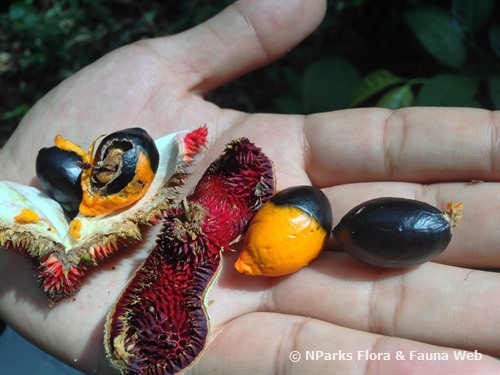




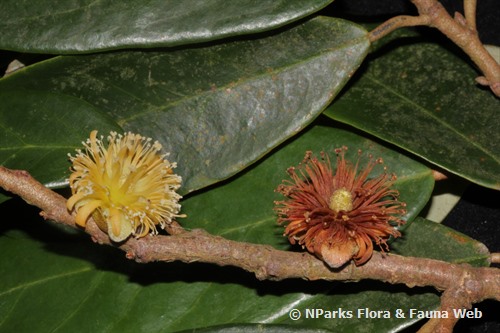
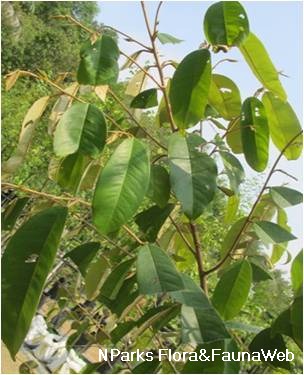

.jpg)
